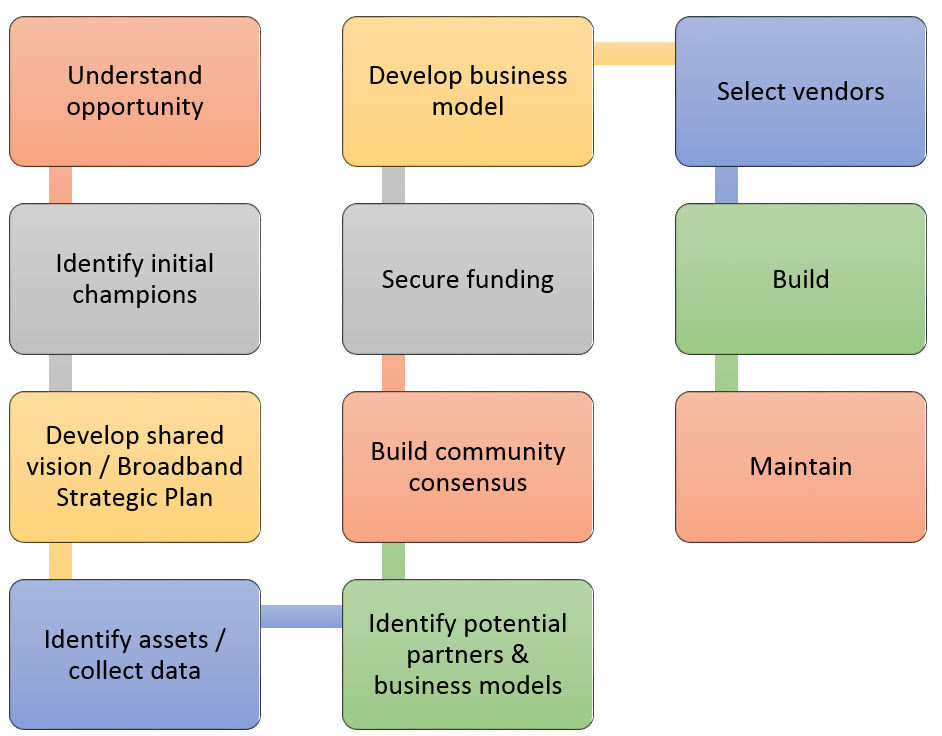Just like the electrical grid in the 20th century, without access to high-speed internet service, or broadband service, communities are at a significant disadvantage in many ways:
- Companies likely won’t locate there
- People will find it more challenging to work (if they require internet access)
- Quality of life suffers (think of things as minor as buffering on Netflix, or as significant as remote health services to save lives)
If you want to bring broadband to your community, what’s involved and where to start?
The good news is that Kentucky is building out high-speed internet connections to all 120 counties, which is what’s typically called the middle mile in an initiative called KentuckyWired. This open access network will allow cities/communities, partnerships, private companies, or other groups to connect and bring that broadband directly to homes and businesses in what’s called the last mile.
There is a LOT involved in undertaking this last mile initiative (see the steps below), but for greatest success the place to start is by understanding the opportunity, getting the right people (champions) to the table, and building a shared vision for what the benefits would be for building out such a network in a Broadband Strategic Plan. 
1. Understand the Opportunity
A lot of people don’t really understand the difference access to high-speed broadband can make. Ten years ago we didn’t think we would be walking around with computers in our pockets that would allow us to communicate with others by voice/video/text, take pictures, and play music.
Without access to running water and electricity, most businesses can’t operate. In another ten years, most potential businesses won’t be able to operate without access to a broadband connection.
With the decline in other sources of income, such as coal, other business opportunities will be enabled by broadband, along with improvements to economic development, along with education, health care, public safety, government services, and community development.
2. Identify Initial Champions
Just like a team of horses, if a bunch of smart, talented, and resourceful people are pulling in different directions, the cart they’re harnessed to won’t go anywhere, and might become destroyed in the process.
If all the horses are pulling in the same direction, they’ll be able to accomplish a lot of work, and carry a heavy load more quickly and with better results.
Ideally, advocates from each of the key sectors–economic development, education, health care, public safety and government services and community development–will participate and communicate.
3. Develop Shared Vision with a Broadband Strategic Plan
Bringing together people from various community sectors is key to define shared vision and goals. An inclusive, facilitated strategic planning process brings together community leaders from public and private sectors in a series of sessions that captures ideas and opportunities and refines them down into a series of concrete goals, strategies, and action plans that can then be funded, staffed, and implemented. The process of engaging, gathering, refining, and communicating repeats until there is a well-understood environment, and a stronger, more cohesive team of leaders for the broadband initiative.
Strategic planning can be conducted using many resources available the Commonwealth of Kentucky’s Office of Broadband Outreach and Adoption.
Solarity has a proven process that we customize to the unique needs of each community.
At Solarity, our niche is to “build success by doing the right things the right way at the right time.”
Doing things right means generating a shared vision of success, developing an environment in which success is possible, selecting the optimal methodologies and tools, and being strategic about when they are applied.
For this initiative, we recommend an approach which will integrate the relevant components of several different methodologies that allow us to ensure we’re doing the right amount of work (not too much OR too little) to produce the right results at the right time. We base our approach on the tools that Kentucky has established, thought leadership, and other techniques we’ve studied, applied, and adapted for use in other successful engagements.
For more information, we’d be glad to chat with you, or come and share a presentation with key leaders in your community. Just contact Cory Camic at cory@solarity.com or 888-272-4494.